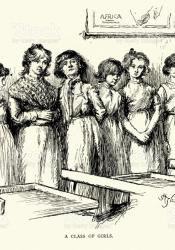Village Schools Privately Opened
In chapter thirty of Jane Eyre, Mr. St. John Rivers offers Jane the opportunity to live on her own and obtain a fraction of independence by working as a teacher. He grants her employment at his new village school where her "scholars will be only poor girls---cottagers' children---at the best, farmers' daughters" (Brontë ch. 30). Prior to the educational reform of the Victorian Era, the only way for young, poor girls to receive an education was to attend either a charity school or a village school. Most village schools were funded and built by private benefactors and entrepreneurs, and the students were mainly taught how to read and write (Harwood 5). Brontë's mention of the village school is significant to the establishment of Jane's position as an education woman in society. As a former governess to a wealthy charge, it would be considered beneath Jane to educate children of the lower-working class; the students would be deemed unworthy of her intelligence. When offering Jane the position, St. John Rivers appears hesitant and insistent on clarification, and it is because he does not want to offend or insult her by offering her a position in association with the lower class (Brontë ch. 30). Jane's acceptance of the position demonstrates her humility and suggests that she values her contribution to society more than she values her position in society.
Works Cited
"A Class of Girls." iStock, media.istockphoto.com/illustrations/victorian-education-class-of-school-girls-19th-century-illustration-id1050385928. Accessed 20 June 2022.
Harwood, Elain. "The Earliest Surviving Schools." England's Schools: History, Architecture and Adaptation, English Heritage, Swindon, 2012, pp. 5-17. Accessed 20 June 2022.

